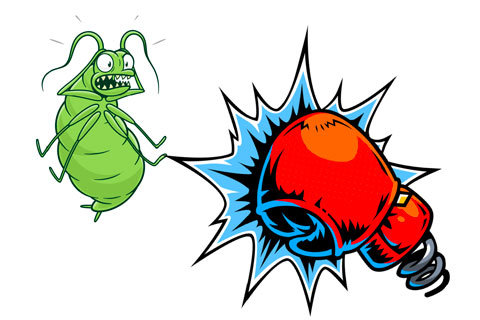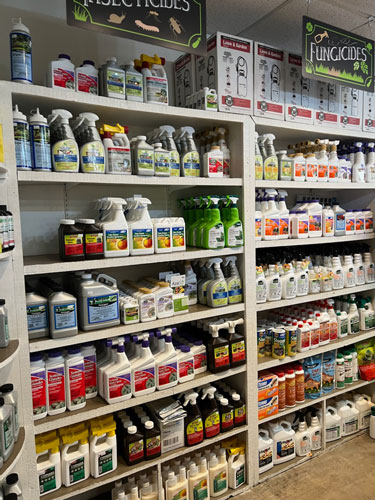4/1/2022
Fighting the Good Fight
Jennifer Polanz

Imagine it’s one of your first seasons as a gardener, and some pest is decimating your prized plant that you spent all winter researching and finally bought at your favorite garden center. How can a retailer help?
Most of the time, those pests are common and already well-known “usual suspects” to the educated long-time garden retailer. But to a newbie gardener, they’re unknown, which means they also don’t know the warning signs or how to treat them. I talked with experts to get the rundown on what the most common pests and diseases are, how to talk to customers about them, and how to make sure they’re successfu the first time around.
Most Common Problems
Clayton Smith is a horticulturist for Monterey Garden Products, and while he’s based in California, he talks to gardeners all over the country about their pest and disease problems. Nearly half of his calls pest-wise are about insects with piercing-sucking mouthparts, which consists of aphids, scales, whiteflies and mealybugs.
Thrips rank up there next, as well as ornamental two spot and red spider mites. “Those are two big ones,” he says of the mites. “People won’t even notice they’re there until they’re really there. You can tell by the mottling effect on the top of the leaf. You’ll start seeing chlorophyll disappearing. You may see some webbing, but you won’t see a lot.”
As an easy way to identify mites, which are virtually always on the bottom of the leaf, he takes a leaf and slaps it on a white piece of paper, looking for “dust particles” moving. In California, too, broad mites are becoming an issue on cannabis. He adds they haven’t seen the broad mite cross over to other crops or ornamentals, but it might be something to watch for.
On the disease side, the most common offenders are powdery mildew, black spot, Anthracnose, Botrytis, Phytophthora, Rhizoctonia and Sclerotinia. Clayton breaks it down further into soft fungus and hard fungus for leaf diseases. The soft fungus would be powdery or downy mildews and rusts, where if you kill the fungus the leaf will come back whole and beautiful. The hard fungus describes brown spot, blackspot, Botrytis and Anthracnose where even if you kill the fungus the spots will remain on the leaves. Phytophthora is more of a water mold than fungi, where Rhizoctonia is a soil-borne fungus that causes issues from the root up to the leaves, and Sclerotinia can cause white mold and stem rot.
What to Ask
Customers may not be able to effectively articulate the problem, especially if they’re new to gardening, so it’s up to the garden center’s employees to ask the right questions.
“I’m known as a needy, greedy baby,” Clayton jokes. “I want to know more because even though I may solve the problem here, it may (really) be 35 or 40 degrees to the side.”
 In other words, the problem might not always be exactly what it looks like at first glance and it may not even be the plant in question—it could be caused by another plant nearby. So he recommends asking questions like, “Where is the plant in question planted?” and “What else is planted around it?” and “What are the conditions like in that area?” Aside from just getting them the right answer, asking these questions also shows you care about their problem.
In other words, the problem might not always be exactly what it looks like at first glance and it may not even be the plant in question—it could be caused by another plant nearby. So he recommends asking questions like, “Where is the plant in question planted?” and “What else is planted around it?” and “What are the conditions like in that area?” Aside from just getting them the right answer, asking these questions also shows you care about their problem.
Pictured: The pesticide and fungicide options at Plants for All Seasons in Houston, Texas.
Clayton also recommends not having the conversation over the phone, a sentiment Victor Flaherty, owner of Plants for All Seasons in Houston, Texas, concurs with.
“People call up and ask on the phone, ‘Do you know what this is?’” he says. “Sometimes we do, but not always. You usually need to see a leaf or a picture or a branch. So we ask them to bring that in to get a better idea of what their real problem is.”
Another key to success, Victor says, is to make sure customers know to report back if the product worked or not. In one instance, they found a pest showing resistance to a control, so they had to switch to a different product for greater success. That feedback from customers was vital in making sure everyone had the same success.
Application
Clayton notes it’s important to ask whether the customer is raising pollinator gardens or is protecting pollinators before recommending any products. In general, to reduce impact on pollinators, customers can apply organic sprays in the evening when pollinators aren’t active. Organic products made with pyrethrins have a short life in the environment, but they need to be sprayed multiple times throughout the insect’s life cycle because they don’t kill the eggs. They’re best for piercing insects.
Meanwhile, products made with Spinosad are most effective for chewing and raking insects because it’s designed to seep into the innerworkings of the leaf and last longer.
For fungus issues, Clayton recommends liquid copper, which can be used as a preventative spray while plants are dormant. Monterey also has a new Complete Disease Control made from Bacillus amyloliquefaciens strain D747 (or Ba) that’s been shown to colonize the root system to protect plants from root diseases.
Victor says they always start with recommending the organic or natural option for pest and disease controls, and go to the synthetic if there’s not a strong option otherwise.
A couple of final notes on the application side—it’s vital to always familiarize yourself with the label, even if it’s a product you’ve known for years. Labels can change, so always read the label and stress to the customer they should read it before application. Also, Clayton notes most of the formulations we have for the home garden market originally came from agriculture (because of the money needed for research and development), so thank a farmer for the products we have today.
What to Watch For
There are several regional pests that could surprise you in your area if you don’t normally have them. Victor notes that three out of the last six years they’ve had infestations of sod webworm, a pest that can decimate a lawn quickly if not controlled. It’s normally found in Florida, Georgia and other southern states, and Victor says, “I’m not exaggerating when I tell you a few falls ago we were selling $50,000 worth of insecticides a week.”
In northern Ohio last fall, armyworm caught retailers, farmers and residents by surprise. Experts believe the armyworms were infesting lawns and crops in the south before catching a ride on summer storm fronts north. Fortunately for us northerners, there are plenty of treatments for these pests and they generally don’t overwinter.
Clayton says, too, with climate change he’s seeing trees under greater stress, which is driving issues like borers for pine trees. A newer invasive pest to watch out for is the spotted lanternfly, which has been found in the mid-Atlantic and Northeast all the way into Pennsylvania and Western Ohio.
“We’re starting to see it in more states that we haven’t seen it in before,” he says. “We’re seeing it … because the plants are being stressed more and they’re more likely to be targeted. Insects can tell when the plants are stressed.”
Another invasive to watch for is the jumping worm. Unlike typical earthworms, the scat the jumping worm leaves in the soil is hard and cannot be broken down, and the worm depletes the soil of nutrients. Clayton says he doesn’t know of any treatment yet for this invasive. They’re currently found in 15 states, mostly around the Great Lakes states, as well as in Missouri, Louisiana, Kansas, Texas and Oregon.
Staff Training
It can be difficult to get employees who interact with customers trained up. Victor Flaherty of Plants for All Seasons provided some details on how they approach pest and disease products (it’s part of their hardlines category, which is their No. 1 sales category).
First, he has the store set up so customers pick plants first, then have to walk through a breezeway where employees write up a ticket they take to the register to check out. During this time they talk to customers about pest and disease control needs, as well as bagged goods and other products. He wants the Q&As to happen then, not at the register.
Here are a few more bullet points from Victor related to training:
• Employee retention—we have been able to retain a great base of experienced employees, and once trained in this area, they can then mentor new employees on the job.
• If an employee doesn’t know an answer, they’re instructed to find an employee that will know, bring that employee to the customer and wait to hear the solution so they know from then on out.
• If a new pest presents itself, someone on our staff will do the research, make a written report and share that with the rest of the staff. Doveweed is a good example. It showed up in our area recently and we hadn’t had experience with it.
• When we add new products, our Solutions Buyer will hold impromptu meetings with staff to give instructions on their use and benefits.
• We offer free samples of products to our staff. You can sell a product with confidence if you’ve personally
experienced great results. Customers don’t want to hear a wishy-washy
recommendation.
• Occasionally, a manufacturer’s rep will hold a product knowledge meeting before opening to answer specific questions about their products. GP